The AMD Radeon R9 Fury Review, Feat. Sapphire & ASUS
by Ryan Smith on July 10, 2015 9:00 AM ESTCompute
Shifting gears, we have our look at compute performance. As compute performance will be more significantly impacted by the reduction in CUs than most other tests, we’re expecting the performance hit for the R9 Fury relative to the R9 Fury X to be more significant here than under our gaming tests.
Starting us off for our look at compute is LuxMark3.0, the latest version of the official benchmark of LuxRender 2.0. LuxRender’s GPU-accelerated rendering mode is an OpenCL based ray tracer that forms a part of the larger LuxRender suite. Ray tracing has become a stronghold for GPUs in recent years as ray tracing maps well to GPU pipelines, allowing artists to render scenes much more quickly than with CPUs alone.

For LuxMark with the R9 Fury X already holding the top spot, the R9 Fury cards easily take the next two spots. One interesting artifact of this is that the R9 Fury’s advantage over the GTX 980 is actually greater than the R9 Fury X’s over the GTX 980 Ti’s, both on an absolute and relative basis. This despite the fact that the R9 Fury is some 13% slower than its fully enabled sibling.
For our second set of compute benchmarks we have CompuBench 1.5, the successor to CLBenchmark. CompuBench offers a wide array of different practical compute workloads, and we’ve decided to focus on face detection, optical flow modeling, and particle simulations.
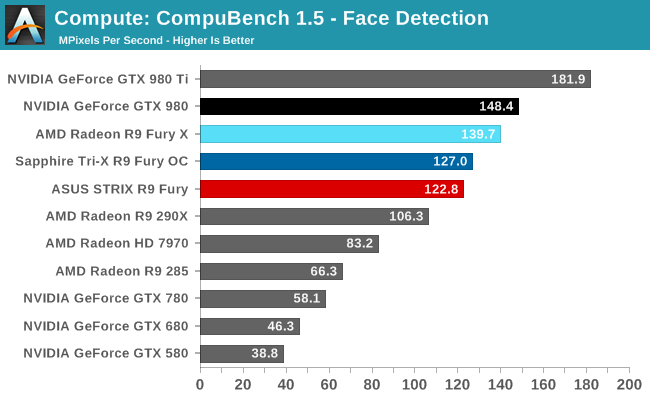
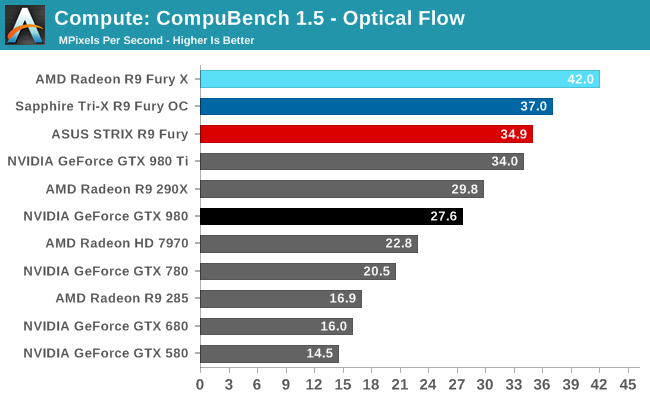

Not unlike LuxMark, tests where the R9 Fury X did well have the R9 Fury doing well too, particularly the optical flow sub-benchmark. The drop-off in that benchmark and face detection is about what we’d expect for losing 1/8th of Fiji’s CUs. On the other hand the particle simulation benchmark is hardly fazed beyond the clockspeed drop, indicating that the bottleneck lies elsewhere.
Our 3rd compute benchmark is Sony Vegas Pro 13, an OpenGL and OpenCL video editing and authoring package. Vegas can use GPUs in a few different ways, the primary uses being to accelerate the video effects and compositing process itself, and in the video encoding step. With video encoding being increasingly offloaded to dedicated DSPs these days we’re focusing on the editing and compositing process, rendering to a low CPU overhead format (XDCAM EX). This specific test comes from Sony, and measures how long it takes to render a video.
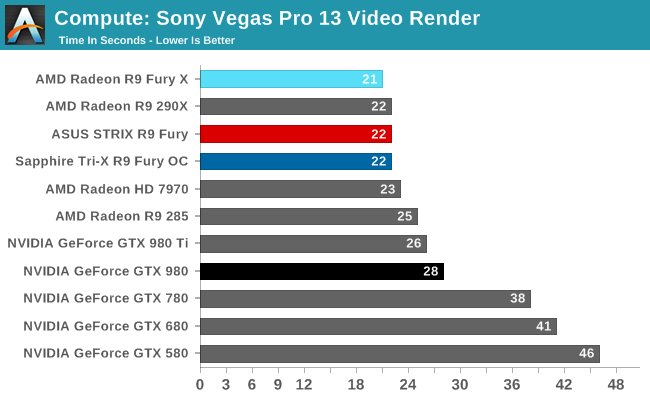
At this point Vegas is becoming increasingly CPU-bound and will be due for replacement. The R9 Fury comes in one second behind the chart-topping R9 Fury X, at 22 seconds.
Moving on, our 4th compute benchmark is FAHBench, the official Folding @ Home benchmark. Folding @ Home is the popular Stanford-backed research and distributed computing initiative that has work distributed to millions of volunteer computers over the internet, each of which is responsible for a tiny slice of a protein folding simulation. FAHBench can test both single precision and double precision floating point performance, with single precision being the most useful metric for most consumer cards due to their low double precision performance. Each precision has two modes, explicit and implicit, the difference being whether water atoms are included in the simulation, which adds quite a bit of work and overhead. This is another OpenCL test, utilizing the OpenCL path for FAHCore 17.
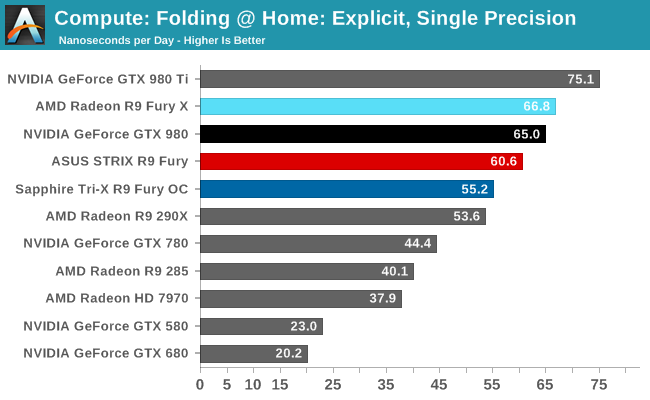
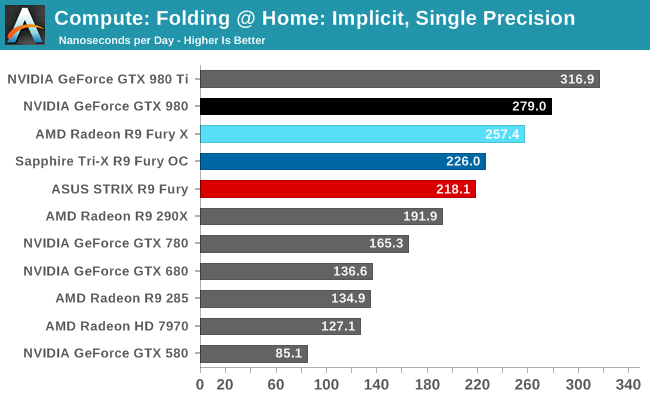

Overall while the R9 Fury doesn’t have to aim quite as high given its weaker GTX 980 competition, FAHBench still stresses the Radeon cards. Under single precision tests the GTX 980 pulls ahead, only surpassed under double precision thanks to NVIDIA’s weaker FP64 performance.
Wrapping things up, our final compute benchmark is an in-house project developed by our very own Dr. Ian Cutress. SystemCompute is our first C++ AMP benchmark, utilizing Microsoft’s simple C++ extensions to allow the easy use of GPU computing in C++ programs. SystemCompute in turn is a collection of benchmarks for several different fundamental compute algorithms, with the final score represented in points. DirectCompute is the compute backend for C++ AMP on Windows, so this forms our other DirectCompute test.
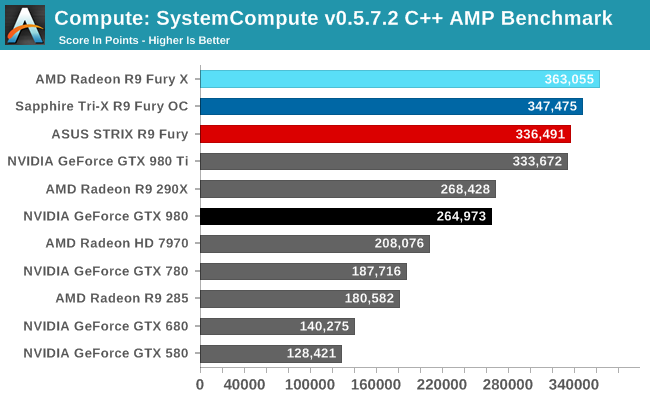
As with our other tests the R9 Fury loses some performance on our C++ AMP benchmark relative to the R9 Fury X, but only around 8%. As a result it’s competitive with the GTX 980 Ti here, blowing well past the GTX 980.










288 Comments
View All Comments
Makaveli - Friday, July 10, 2015 - link
Why would it perform the same this Fury is not throttling due to heat it has less performance due to having less hardware.tviceman - Friday, July 10, 2015 - link
So it looks like OC'd GTX 980 @ 1440p is going to be faster, on average, than an OC'd Fury @ 1440p.....refin3d - Friday, July 10, 2015 - link
Potentially, we don't really know what is going to happen exactly with the cards being voltage locked.tviceman - Friday, July 10, 2015 - link
That's easy to deduce: ~8% more OC performance for 150-200 more watts power consumption.ToTTenTranz - Friday, July 10, 2015 - link
No Hawaii in the compute tests?Ryan Smith - Friday, July 10, 2015 - link
Whoops. Forgot to include them when generating the graphs. I'll go fill those intitan13131 - Friday, July 10, 2015 - link
It would be cool if damaged chips weren't all disabled to the same level i.e. only the faulty parts were disabled on each chip. Then amd could charge a little more for something they have already produced and we would have access to cards closer to the performance of the fury x (with a little overclocking) for less. Assuming the ref cooler can handle the extra heat.Asomething - Friday, July 10, 2015 - link
then they would have to market, package and ship the extra cards as well as optimize for another chip, used to be you could unlock the salvage chips if the damages were not too bad (some fully unlocked into the full chips in some cases where chips are cut simply to meet the demand for the cut chips) but amd and nvidia now laser off the disabled parts to stop that.Kevin G - Friday, July 10, 2015 - link
This really highlights the idea that AMD should have focused on increasing ROP count over the massive amount of shaders. HBM not only increased bandwidth but the delta color compression increased effective bandwidth as well but AMD didn't alter the number of ROPs in the design.extide - Friday, July 10, 2015 - link
It's not the ROPs. Look at the 3dmark tests, it tops the Pixel throughput charts.What it needs is more geometry power, not ROPs. Look at the tessellation results, the Furys can't even keep up with a GTX 780. THAT is their issue, they need more geometry horsepower.